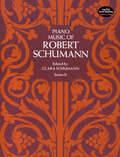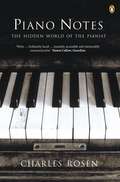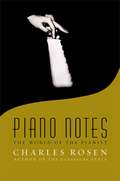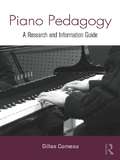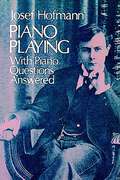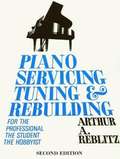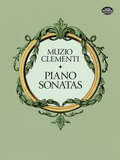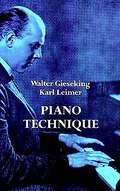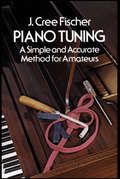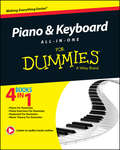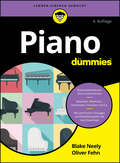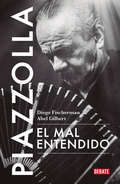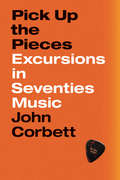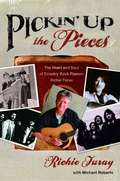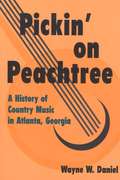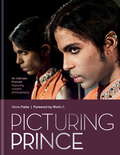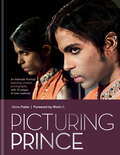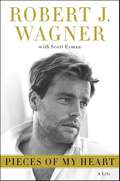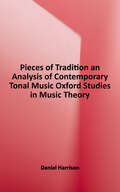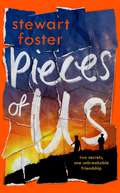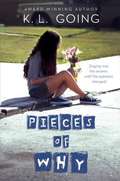- Table View
- List View
Piano Music of Robert Schumann, Series II (Dover Classical Piano Music)
by Robert Schumann Clara SchumannDover Publications continues its series of playing editions of musical masterpieces with this selection of Robert Schumann's later compositions for solo piano, edited by Clara Schumann. This second volume contains the major compositions from the period 1838-53: "Humoreske," "Novelletten," "Sonate No. 2," Nachtstücke," "Faschingsschwank aus Wien," "42 Clavierstücke für die Jugend," "4 Fugen," "Waldscenen," "Bunte Blätter," and "3 Clavier-Sonaten für die Jugend."This book has been especially designed as a playing edition -- the noteheads are large and easily readable at the piano, and the margins and spaces between staves are adequate for written notes, fingerings, and turnovers. It is also most useful for analysis or as accompaniment to recordings.
Piano Notes: The Hidden World of the Pianist
by Charles RosenIn this eloquent, intimate exploration of the delights and demands of the piano, world-renowned concert pianist and music writer Charles Rosen draws on a lifetime's wisdom to consider every aspect of the instrument: from what makes a beautiful sound to suffering from stage fright, from the physical challenges of playing to tales of great musicians, including Vladimir Horowitz's recording tricks, Rachmaninov's hands and why Artur Rubenstein applied hairspray to the keys. Gracefully blending anecdote, history, expertise and memoir, Piano Notes will enchant anyone with a passion for music.
Piano Notes: The World of the Pianist
by Charles RosenCharles Rosen is one of the world's most talented pianists -- and one of music's most astute commentators. Known as a performer of Bach, Beethoven, Stravinsky, and Elliott Carter, he has also written highly acclaimed criticism for sophisticated students and professionals. In Piano Notes, he writes for a broader audience about an old friend -- the piano itself. Drawing upon a lifetime of wisdom and the accumulated lore of many great performers of the past, Rosen shows why the instrument demands such a stark combination of mental and physical prowess. Readers will gather many little-known insights -- from how pianists vary their posture, to how splicings and microphone placements can ruin recordings, to how the history of composition was dominated by the piano for two centuries. Stories of many great musicians abound. Rosen reveals Nadia Boulanger's favorite way to avoid commenting on the performances of her friends ("You know what I think," spoken with utmost earnestness), why Glenn Gould's recordings suffer from "double-strike" touches, and how even Vladimir Horowitz became enamored of splicing multiple performances into a single recording. Rosen's explanation of the piano's physical pleasures, demands, and discontents will delight and instruct anyone who has ever sat at a keyboard, as well as everyone who loves to listen to the instrument. In the end, he strikes a contemplative note. Western music was built around the piano from the classical era until recently, and for a good part of that time the instrument was an essential acquisition for every middle-class household. Music making was part of the fabric of social life. Yet those days have ended. Fewer people learn the instrument today. The rise of recorded music has homogenized performance styles and greatly reduced the frequency of public concerts. Music will undoubtedly survive, but will the supremely physical experience of playing the piano ever be the same?
Piano Pedagogy: A Research and Information Guide (Routledge Music Bibliographies)
by Gilles ComeauPiano Pedagogy: A Research and Information Guide provides a detailed outline of resources available for research and/or training in piano pedagogy. Like its companion volumes in the Routledge Music Bibliographies series, it serves beginning and advanced students and scholars as a basic guide to current research in the field. The book will includes bibliographies, research guides, encyclopedias, works from other disciplines that are related to piano pedagogy, current sources spanning all formats, including books, journals, audio and video recordings, and electronic sources.
Piano Playing: With Piano Questions Answered (Dover Books On Music: Piano #1)
by Josef HofmannJosef Hofmann (1876-1957) was a master of piano technique and an artist who had few equals at the keyboard. A student of Anton Rubinstein and a leading exponent of the works of Chopin, Liszt, and Schumann, he always balanced his virtuoso playing with a firm adherence to the piece as written. It is this balanced approach to piano playing that he advocates in this highly regarded volume on piano technique.The first section of the book contains a discussion of the rules and tricks of correct piano playing: touch, methods of practicing, the use of the pedal, playing the piece as it is written, "How Rubinstein Taught Me to Play," and indispensables in pianistic success. The second, much longer, section contains Hofmann's answers to specific questions sent to him by piano students and amateurs: questions on positions of the body and hand, actions of the wrist and arm, stretching, staccato, legato, precision, fingering, octaves, the pedals, practice, marks and nomenclature, phrasing, rubato, theory, transposing, and much more.Full of important background information that is highly useful to every piano player, this book will set students on the right track in their studies and allow every amateur to measure the level of his commitment and the quality of the instruction he is receiving. For insight into many facets of playing the piano, there is no better guide than Josef Hofmann.
Piano Servicing, Tuning, and Rebuilding: For the Professional, the Student, the Hobbyist
by Arthur A. ReblitzThe second edition of this world famous book puts into clear pictures and language how anyone handy with tools can repair, regulate, maintain, and even completely rebuild a piano.
Piano Sonatas
by Muzio ClementiTreasury of keyboard music by extremely influential Italian composer includes 10 of his finest sonatas: Sonata in G Minor, Op. 7, No. 3; Sonata in F Minor, Op. 13, No. 6; Sonata in B Minor, Op. 40, No. 2; Sonata in G Minor, Op. 50, No. 3 (Didone Abbandonata); Sonata in D Major, Op. 25, No. 6; Sonata in A Major, Op. 33, No. 1; 4 more. Reprinted from authoritative editions published by C. F. Peters and Kistner & Siegel & Co.
Piano Starts Here: The Young Art Tatum
by Robert Andrew ParkerRegardless of whether they've heard of jazz or Art Tatum, young readers will appreciate how Parker uses simple, lyrical storytelling and colorful and energetic ink-and-wash illustrations to show the world as young Art Tatum might have seen it. Tatum came from modest beginnings and was nearly blind, but his passion for the piano and his acute memory for any sound that he heard drove him to become a virtuoso who was revered by both classical and jazz pianists alike. Included in the back matter is a biography and bibliography.<P><P> Winner of the Schneider Family Book Award
Piano Technique
by Walter Gieseking Karl LeimerThe volume presents two book by Walter Gieseking, foremost pianist of his generation, and his teacher for five years, Karl Leimer, that have long been sought after by students and teachers looking for a radical approach toward developing not only finger-technique but expression-technique. Emphasis throughout is on listening to one's self and proper understanding as the basis of proper technique for the piano.In book one, originally titled The Shortest Way to Pianistic Perfection, Gieseking and Leimer work with a series of piano works -- a study from Lebert and Stark, Bach's Two- and Three-Part Inventions in C, and Beethoven's Sonata in F Minor, Op. 2, No. 1. Before beginning to play, the student is asked to visualize each piece through silent reading. Through Leimer's instruction in this area the student soon discovers how to approach each piece as not merely a series of notes to memorize but as a coherent musical structure to understand. Following are instructions on natural interpretation, with consideration of touch, relaxation, and proper emphasis in the practice. Also given are notes on such topics as etudes, scales, broken chords, the trill, and tranquility.In book two, Rhythmics, Dynamics, Pedal and Other Problems of Piano Playing, Leimer carries his method of visualization further with a study of the Allemande from Bach's French Suite in E Major. Following are further exercises and practices for developing other pianistic technique with reference to works of other composers. Specific exercises which cover rhythmics, dynamics, and phrasing are designed so that they will benefit not only the pianist but also performers on other instruments. Extensive chapters on variety of touch and the pedal give a great number of techniques and exercises for extending the expressive and dynamic range.
Piano Tuning: A Simple and Accurate Method for Amateurs (Dover Books On Music: Piano)
by J. Cree FischerIf you have a note that has dropped in pitch, do you have to call in the tuner? A stuck key? Sympathetic rattle? Missing bridles? A broken hammer shank? An unglued ivory? The answer, in each case, is no: you can make all of these repairs yourself!This is the clearest and most complete book available for beginning tuners and amateur pianists. It explains all the basic processes practically and with model clarity. A non-musician can use this book without too much difficulty.You will learn how upright, grand, and square actions work, and how to take care of the smallest repairs — repairing stuck keys, poorly adjusted bottoms and capstans, crowded back checks, felts and leather on the hammers, hammer stems; softening damper and hammer felts; installing new bridles; eliminating "sympathetic rattle"; all with a minimum of tools and training.You will learn a professional method of tuning based on slightly flattened fifths, where only the octave and the upward fifth intervals are used. This is one of the easiest systems to learn, one capable of a great deal of control, and one perfectly suited to adjusting one or two keys. It is a tested method especially right for amateurs working without a teacher, and a method that trains the ear for other recommended systems. The author also explains "beats," the theory of the tempered scale, and useful experiments you can make with harmonic phenomena.If you want to experiment with tuning a piano, there is no better book to start with. It will help performers and teachers make occasional repairs and learn the structure and scale of the piano. Those who want to know how pianos work will find this book both clear and useful.
Piano and Keyboard All-in-One For Dummies
by Consumer DummiesThe go-to reference for aspiring pianists and keyboard playersPiano & Keyboard All-in-One For Dummies makes it easier and more fun than ever to make music! If you don't know how to read music, this book explains in friendly, uncomplicated language all the basics of music theory, and applies it to playing the piano and keyboard. And if you've been playing for awhile--or took lessons when you were a child but haven't played since--you can pick up some valuable tips to improve your playing, or use the book as a refresher course.This indispensible resource combines the best of For Dummies books, including Piano For Dummies, Keyboard For Dummies, Music Theory For Dummies, and Piano Exercises For Dummies to get you up and running in no time. The handy reference helps you to master the traditional black-and-white keys and gives you an understanding of the possibilities that unfold when those black-and-whites are connected to state-of-the-art music technology.Discover the secrets for becoming a master on the piano and keyboardImprove your skills with a wealth of easy-to-apply piano exercisesTap into your creativity and get the lowdown on composing an original songFind out how to use keyboards anywhere using external speakers, amps, home stereos, computers, and tabletsDive right in! This comprehensive book offers the most complete learning experience for aspiring pianists, keyboard enthusiasts, and students of music.
Piano für Dummies (Für Dummies)
by Blake Neely Oliver FehnTasten Sie sich an das Pianospielen heran Kaum ein Instrument fasziniert so wie das Piano, sei es als Klavier, Keyboard oder Orgel. Blake Neely und Oliver Fehn bringen Ihnen alles bei, was Sie über die 88 Tasten, drei Pedale und zehn Finger wissen müssen. Sie erhalten eine Einführung in die Rhythmen, Melodien und Harmonien, in die Tonarten Akkorde und Co. So lernen Sie Schritt für Schritt Noten zu lesen, Ihre Finger auf die richtigen Tasten zu setzen, erste Lieder zu spielen und Ihre Spieltechnik nach und nach zu verfeinern. Hörbeispiele zum Download helfen Ihnen dabei. Lernen Sie Klavierspielen ohne Vorkenntnisse mitbringen zu müssen! Sie erfahren Wissenswertes zum Kauf Ihres Instruments Wie eine Tonleiter aufgebaut ist Wie Sie Akkorde greifen – in Dur und Moll Wie Sie Ihr Klavierspiel mit Tremolos, Trillern und Dynamik aufpeppen
Piano: The Making of a Steinway Concert Grand
by James BarronAn alluring exploration of the people and the legendary craftsmanship behind a single Steinway pianoLike no other instrument, a grand piano melds engineering feats with the magical sounds of great music: the thunder of a full-throated bass, the bright, delicate trill of the upper treble. Alone among the big piano companies, Steinway still crafts all of its pianos largely by hand, imbuing each one with the promise and burden of its brand. In this captivating narrative, James Barron of The New York Times tells the story of one Steinway piano, from raw lumber to finished instrument. Barron follows that brand-new piano-known by its number, K0862-on its eleven-month journey through the Steinway factory, where time-honored manufacturing methods vie with modern-day industrial efficiency. He looks over the shoulders of men and women-some second- and third-generation employees, some recently arrived immigrants-who transform wood and steel into a concert grand. Together, they carry on the traditions begun more than 150 years ago by the immigrants who founded Steinway & Sons-a family that soared to prominence in the music world and, for a while, in New York City's political and economic life. Barron also explores the art and science of developing a piano's timbre and character before its first performance, when the essential question will be answered: Does K0862 live up to the Steinway legend?From start to finish, Piano will charm and enlighten music lovers.
Piazzolla. El mal entendido
by Diego Fischerman Abel GilbertPiazzolla. El mal entendido es la biografía definitiva de uno de los compositores de tango más importantes del mundo. La vida y la obra de Astor Piazzolla transcurrieron entre su demonización y el asombrado reconocimiento. Fue el emblema sonoro de una ciudad que buscaba estar a tono con su tiempo y sus aspiraciones. A un siglo de su nacimiento, esta nueva edición de Piazzolla. El mal entendido recupera la trama artística, cultural y política que acompañó al bandoneonista desde su aparición fulgurante junto a Aníbal Troilo hasta su inserción internacional más allá del tango. El ensayo intenta ser un puente crítico de acercamiento a una música que no deja de abrirse a nuevos sentidos y reflexiones. "Este libro siempre ha tratado de ser un puente (uno más) con aquello que nos legó Piazzolla, un modo reflexivo de acercamiento a lo que, primero, llegó como una vibración: el aire de Buenos Aires en movimiento", dicen Fischerman y Gilbert.
Pick Up the Pieces: Excursions in Seventies Music
by John CorbettUnless you lived through the 1970s, it seems impossible to understand it at all. Drug delirium, groovy fashion, religious cults, mega corporations, glitzy glam, hard rock, global unrest—from our 2018 perspective, the seventies are often remembered as a bizarre blur of bohemianism and disco. With Pick Up the Pieces, John Corbett transports us back in time to this thrillingly tumultuous era through a playful exploration of its music. Song by song, album by album, he draws our imaginations back into one of the wildest decades in history. Rock. Disco. Pop. Soul. Jazz. Folk. Funk. The music scene of the 1970s was as varied as it was exhilarating, but the decade’s diversity of sound has never been captured in one book before now. Pick Up the Pieces gives a panoramic view of the era’s music and culture through seventy-eight essays that allow readers to dip in and out of the decade at random or immerse themselves completely in Corbett’s chronological journey. An inviting mix of skilled music criticism and cultural observation, Pick Up the Pieces is also a coming-of-age story, tracking the author’s absorption in music as he grows from age seven to seventeen. Along with entertaining personal observations and stories, Corbett includes little-known insights into musicians from Pink Floyd, Joni Mitchell, James Brown, and Fleetwood Mac to the Residents, Devo, Gal Costa, and Julius Hemphill. A master DJ on the page, Corbett takes us through the curated playlist that is Pick Up the Pieces with captivating melody of language and powerful enthusiasm for the era. This funny, energetic book will have readers longing nostalgically for a decade long past.
Pickin' Up the Pieces: The Heart and Soul of Country Rock Pioneer Richie Furay
by Michael Roberts Richie FurayWhen a young Richie Furay moved to New York hoping to make it big in folk music, God wasn't one of his concerns. But destiny was. Later, when he started Buffalo Springfield with Neil Young and Stephen Stills, it seemed Furay's destiny had finally arrived. Although the band recorded only three albums, it remains a touchstone of sixties rock music-with all five band members now enshrined in the Rock and Roll Hall of Fame. Furay remained a musical pioneer, forming Poco and recording some of the first-and best-country rock music of the sixties and seventies. His work was a major influence on the Eagles and innumerable other bands. But he still had not found his destiny. It wasn't until his marriage almost disintegrated that Furay confronted his need for God. After co-founding two legendary bands and recording with a rock super-group, Richie Furay finally found his destiny. The long journey took him from sold-out arena concerts to the pulpit of a Colorado church, from rock royalty to the Rock of Ages.Destiny is often found in the places where we're not looking. As you follow the twists and turns in Richie Furay's inspiring journey, you'll gain fresh insight into your own.From the Trade Paperback edition.
Pickin' on Peachtree: A History of Country Music in Atlanta, Georgia (Music in American Life)
by Wayne W. DanielAtlanta played a major role in launching the country music industry in the early 1920s and remained one of the nation’s leading country music centers for four decades. Also a major recording center for twenty years, the city was visited regularly by representatives of New York record companies who traveled south to scout for singers and musicians. During the 1950s, Atlanta’s television stations drew on the talent that had entertained in the area for years to assemble long-running, popular country music shows. Using fresh and fascinating information gleaned from newspaper archives, personal interviews, and other sources, Wayne W. Daniel takes readers from early fiddling conventions through the beginnings of the country music industry, to the early days of country programming on radio, and on through Atlanta’s importance as a regional recording center. He includes an analysis of the role television has played from the 1950s to the present. “If there are still people around who think country music moved right out of the hills directly to Nashville, Wayne Daniel’s book should disabuse them of that. Atlanta was country music’s real birthplace, and has remained a vital and energetic center; Pickin ’ on Peachtree presents a wealth of new information and research, and establishes the importance of Atlanta in the rise of one of America’s most unique art forms.” -- Charles Wolfe, author of Tennessee Strings and Kentucky Country “In this thoroughly researched history of country music in Atlanta, Wayne Daniel explores the major artists, promoters, and industry executives who gave Atlanta’s country music its luster. . . . No one interested in country music, whether in fiddle conventions of the 1910s, the ‘golden age’ of recordings of the 1920s, the early radio barn dance broadcasts of the 1930s and ’40s, or country music on television in the ’50s and beyond will fail to find something of interest in Pickin ’ on Peachtree. -- Norm Cohen, author of Long Steel Rail: The Railroad in American Folksong Wayne w. Daniel is the author of more than 75 articles in Bluegrass Unlimited, Journal of Country Music, Devil’s Box, and other publications.
Picturing Prince: An Intimate Portrait
by Steve ParkePICTURING PRINCE sees the late icon's former art director, STEVE PARKE, revealing stunning intimate photographs of the singer from his time working at Paisley Park. At least half of the images in the book are exclusively published here for the first time; most other images in the book are rare to the public eye.Alongside these remarkable images are fifty engaging, poignant and often funny written vignettes by Parke, which reveal the very human man behind the reclusive superstar: from shooting hoops to renting out movie theatres at 4am; from midnight requests for camels to meaningful conversations that shed light on Prince as a man and artist. STEVE PARKE started working with Prince in 1988, after a mutual friend showed Prince some of Steve's photorealistic paintings. He designed everything from album covers and merchandise to sets for Prince's tours and videos. Somewhere in all of this, he became Paisley Park's official art director. He began photographing Prince at the request of the star himself, and continued to do so for the next several years. The images in this book are the arresting result of this collaboration.
Picturing Prince: An Intimate Portrait
by Steve ParkePICTURING PRINCE sees the late icon's former art director, STEVE PARKE, revealing stunning intimate photographs of the singer from his time working at Paisley Park. At least half of the images in the book are exclusively published here for the first time; most other images in the book are rare to the public eye.Alongside these remarkable images are fifty engaging, poignant and often funny written vignettes by Parke, which reveal the very human man behind the reclusive superstar: from shooting hoops to renting out movie theatres at 4am; from midnight requests for camels to meaningful conversations that shed light on Prince as a man and artist. STEVE PARKE started working with Prince in 1988, after a mutual friend showed Prince some of Steve's photorealistic paintings. He designed everything from album covers and merchandise to sets for Prince's tours and videos. Somewhere in all of this, he became Paisley Park's official art director. He began photographing Prince at the request of the star himself, and continued to do so for the next several years. The images in this book are the arresting result of this collaboration.
Picturing Prince: An Intimate Portrait
by Steve ParkePICTURING PRINCE sees the late icon's former art director, STEVE PARKE, revealing stunning intimate photographs of the singer from his time working at Paisley Park. At least half of the images in the book are exclusively published here for the first time; most other images in the book are rare to the public eye.Alongside these remarkable images are fifty engaging, poignant and often funny written vignettes by Parke, which reveal the very human man behind the reclusive superstar: from shooting hoops to renting out movie theatres at 4am; from midnight requests for camels to meaningful conversations that shed light on Prince as a man and artist. STEVE PARKE started working with Prince in 1988, after a mutual friend showed Prince some of Steve's photorealistic paintings. He designed everything from album covers and merchandise to sets for Prince's tours and videos. Somewhere in all of this, he became Paisley Park's official art director. He began photographing Prince at the request of the star himself, and continued to do so for the next several years. The images in this book are the arresting result of this collaboration.
Picturing Prince: An Intimate Portrait
by Steve ParkePICTURING PRINCE sees the late icon's former art director, STEVE PARKE, revealing stunning intimate photographs of the singer from his time working at Paisley Park. At least half of the images in the book are exclusively published here for the first time; most other images in the book are rare to the public eye.Alongside these remarkable images are fifty engaging, poignant and often funny written vignettes by Parke, which reveal the very human man behind the reclusive superstar: from shooting hoops to renting out movie theatres at 4am; from midnight requests for camels to meaningful conversations that shed light on Prince as a man and artist. STEVE PARKE started working with Prince in 1988, after a mutual friend showed Prince some of Steve's photorealistic paintings. He designed everything from album covers and merchandise to sets for Prince's tours and videos. Somewhere in all of this, he became Paisley Park's official art director. He began photographing Prince at the request of the star himself, and continued to do so for the next several years. The images in this book are the arresting result of this collaboration.
Pieces of My Heart: A Life
by Robert J. Wagner Scott EymanThe Hollywood icon tells about his rise to Hollywood stardom among legends like Cary Grant and Barbara Stanwyck and his troubled marriage, divorce, and remarriage to starlet Natalie Wood.In the revelation-filled memoir from one of Hollywood’s most talented actors, readers have a candid and deeply personal look at the life and career of Robert Wagner. Wagner’s long career began in the Hollywood of the 1950s, when studios were dominant and even the love lives of actors were dictated by what benefited the studio. His memoirs will chronicle in a very personal way his rise to stardom, his decline, and his resurrection. Wagner will talk candidly about his famous relationship with Natalie Wood and the circumstances surrounding her tragic death. His friendships and stories include major Hollywood personalities in the last half of the 20th century.When his family moved to Los Angeles, a young Wagner held a variety of jobs (including one as a caddy for Clark Gable) while pursuing his goal, but it was while dining with his parents at a restaurant in Beverly Hills that he was “discovered” by a talent scout.Known as much for his on-screen abilities as his off-screen personal heartbreak, Wagner will discuss for the first time his complicated and ultimately tragic relationship with Hollywood sweetheart Natalie Wood. It was implied that Wagner played a role in Natalie Wood’s tragic drowning off the coast of Catalina Island in 1981 and Wagner, for the first time ever, will set the record straight.With at least two dozen photos to illustrate his real Hollywood-style tell-all, this will be the extremely candid autobiography of Robert Wagner.
Pieces of Tradition: An Analysis of Contemporary Tonal Music
by Daniel HarrisonThis book is about how music "in a key" is composed. Further, it is about how such music was composed when it was no longer compulsory to do so, starting a few years before the First World War. In an eclectic journey through the history of compositional technique, Daniel Harrison contends that the tonal system did not simply die out with the dawn of the twentieth century, but continued to supplement newer techniques as a compelling means of musical organization, even into current times. Well-known art music composers such as Bartok, Hindemith, Prokofiev, and Messiaen are represented alongside composers whose work moves outside the standard boundaries of art music: Leonard Bernstein, Murice Durufle, Frank Martin, Xiaoyong Chen. Along the way, the book attends to military bugle calls, a trailer before a movie feature, a recomposition of a famous piece by Arnold Schoenberg, and the music of Neil Diamond, David Shire, and Brian Wilson. A celebration of the awesome variety of musical expressions encompassed in what is called tonal music, Pieces of Tradition is a book for composers seeking ideas and effects, music theorists interested in its innovations, and all those who practice the analysis of composition in all its modern and traditional variations.
Pieces of Us
by Stewart FosterTwo secrets, an unbreakable bond . . . a powerful and heartbreaking love letter to a life-changing friendship, from award-winning author, Stewart Foster. I wish you were here, because maybe this isn&’t a story, or a diary. Perhaps it&’s just the longest thank you letter a friend could ever write. As the summer before college begins, Jonas is hiding a secret. He suffers with bulimia, but no one knows. Not even he knows how bad it really is. Until he meets Louis, a confident dreamer who believes in a better future for Jonas and together they enjoy a sun-kissed summer filled with music, memories and life-changing moments. But when tragedy strikes, Jonas must decide if he has the strength to face things alone . . . Writing from personal experience, an award-winning author shines an important light on difficult themes of illness, mental health, and grief in a redemptive story of friendship, for readers of Meg Rosoff and Sarah Crossan. Warning: contains some themes that readers may find upsetting, including disordered eating.
Pieces of Why
by K. L. GoingFrom the award winning author of Fat Kid Rules the World and The Liberation of Gabriel King comes a lyrical, middle grade gem that asks all the hard questions and hits all the right notes--perfect for fans of Cynthia Rylant and Mockingbird by Kathryn ErskineTia lives with her mom in a high-risk neighborhood in New Orleans and loves singing gospel in the Rainbow Choir with Keisha, her boisterous and assertive best friend. Tia's dream is to change the world with her voice; and by all accounts, she might be talented enough. But when a shooting happens in her neighborhood and she learns the truth about the crime that sent her father to prison years ago, Tia finds she can't sing anymore. The loss prompts her to start asking the people in her community hard questions--questions everyone has always been too afraid to ask.Full of humanity, Pieces of Why is a timely story that addresses grief, healing, and forgiveness, told through the eyes of a gifted girl who hears rhythm and song everywhere in her life.dcover edition.
